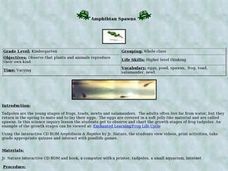Curated OER
Life Cycle of a Salamander
Third graders examine the life cycle of a salamander. For this life cycles lesson, 3rd graders view a PowerPoint presentation about the life cycle of a salamander. Students take the temperature of a toy salamander with a thermometer and...
Curated OER
In the Field with Salamanders
Learners observe salamanders, take pictures of them, and classify them into an online format. In this animal classification lesson, students use collection materials and digital camera to photograph and observe salamanders. Learners...
Curated OER
A STEP IN SPECIATION
Students place different subspecies of a CA salamander are placed on grid map of CA according to where samples were collected. Then discuss patterns of their distribution, their likely evolutionary relationships, and probable sequence of...
Curated OER
Amphibians
In this amphibian worksheet, learners will review the characteristics of the class Amphibia, including frogs and toads, salamanders, and caecilians. This worksheet has 3 short answer questions, 5 matching questions, 6 multiple choice,...
Howard Hughes Medical Institute
Tissue Regeneration in Animals
Every species regenerates at least one tissue or organ in their bodies. Learn about different regeneration processes in animals. An intriguing presentation specifically discusses starfish, hydras, planaria, salamanders, mice, humans,...
Curated OER
The Salamander Room
Young scholars examine how each animal's habitat provides what that animal needs for survival. They discuss what an animal needs to survive-food, shelter, water, and space.
Curated OER
Reptile and Amphibian Anatomy
Young scholars identify and interpret the various differences between reptiles and amphibians. Then they draw an amphibian and reptile and correctly label their body parts. Students also invent new reptiles and amphibians, sketch how...
Curated OER
Animal Classifications
While short, this resource could be used as an overview of amphibians. The presentation lists the characteristics of amphibians and provides several examples. For use in a classroom, a teacher could add information.
Curated OER
Talking 'Bout Regeneration
Young scholars research the regenerative capabilities of certain organisms. They present their findings at a student regeneration symposium aimed at exploring the possibilities of human regeneration.
Curated OER
How Do Animals Grow and Change?
In this animal growth worksheet, students will write in the 3 steps in a salamander's life cycle, from egg to adult. This worksheet is a graphic organizer.
Curated OER
Reptile and Amphibian Word Search
In this reptile and amphibian worksheet, students complete a word search puzzle by finding 24 terms associated with the different types of reptiles and amphibians.
National Science Teachers Association
Hop into Action
Young scientists find out what makes amphibians such unique and interesting animals in this simple life science lesson. After looking at pictures and discussing the characteristics of amphibians, learners complete a series of three Venn...
American Museum of Natural History
What's This? Breathing
Crazy fact: Some animals can survive months without oxygen. An online resource describes some unique ways animals collect oxygen and even live without it for an extended time. Learners read about these special animals and use pop-up...
Curated OER
Independence and Conservation
Students read an original story "Brothers of the Rainforest" downloaded from the internet site provided. Students investigate the impact of the demise of a particular species on the rest of the environment. Students participate in a...
Curated OER
Mark, Recapture, Sampling
Learners conduct a simulation to explore how scientists estimate the size of animal populations. They analyze a random sample and then extrapolate those results to a larger population. Additionally, they will apply the principals of...
Curated OER
Interactions of Living Things
Is it a producer, carnivore, omnivore, scavenger, or decomposer? Different relationships among organisms are explored here. It is a simple, multiple choice assignment. Use it as a quick warm-up or quiz.
Curated OER
Examining the Stages in Ecological Succession
In this ecosystems worksheet, students use illustrations and descriptions of four ponds to determine the order of succession. Students complete 8 fill in the blank questions and 5 short answer questions.
Biology Junction
Amphibians
Biologists know of more than 2,300 living species of amphibians. Learn more about the four orders of amphibians with an interesting presentation. It explains the similarities and differences between the thousands of species of...
American Museum of Natural History
The Tree of Life
Groups of species can have more in common than meets the eye. An interactive cladogram shows some of the connections between important groups of species. Learners click on sections of the diagram to learn more about the connections or on...
Curated OER
The Scientific Method
Young scholars examine the Scientific Method. They will discover the value in being observant, organized, and thorough with regard to science. They will also explore how these traits can serve them well in other areas of life.
Curated OER
Prairie Scales and Prairie Smoothies
Sixth graders explore the animals that live on the prairie and identify differences between amphibians and reptiles and the adaptations each have made to live on the prairie.
Curated OER
Mapping Where Animals Live
What type of reptiles live in New York State? This instructional activity gets the class thinking about what factors determine where particular animals live. They analyze the Hudson Valley environment, identify specific reptile and...
NWT Literacy Council
Readers Theatre Scripts
Engage and entertain young learners with this collection of readers theatre activities. With over 25 different scripts, a wide range of topics are covered from simple counting and rhyming exercises to adaptions of popular children's...
Curated OER
Amphibian Spawns
Students observe tadpoles as they gradually change into adults. In this amphibian biology lesson, students watch tadpoles in a tank in the classroom, keep a daily record of what they observe, and chart the growth development of the...
Other popular searches
- Salamanders Internal Organs
- Salamanders Life Cycle
- K 2 Life Science Salamander
- Tiger Salamanders
- Salamanders for Sale
- Aquatic Salamanders
- Keeping Salamanders
- Salamanders Feeding and Care
- Chin Ease Salamanders
- Chinease Salamanders
- New England Salamanders
- Internal Organs Salamander

























